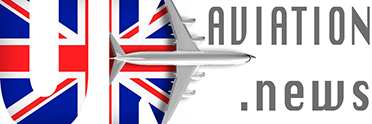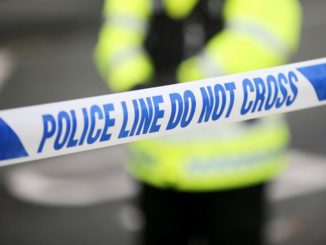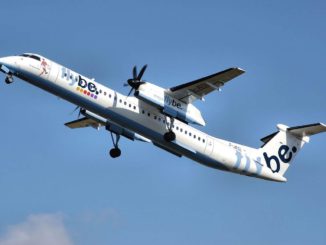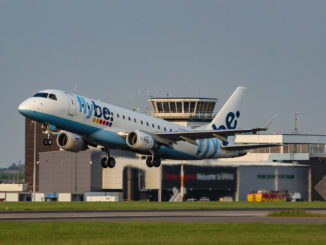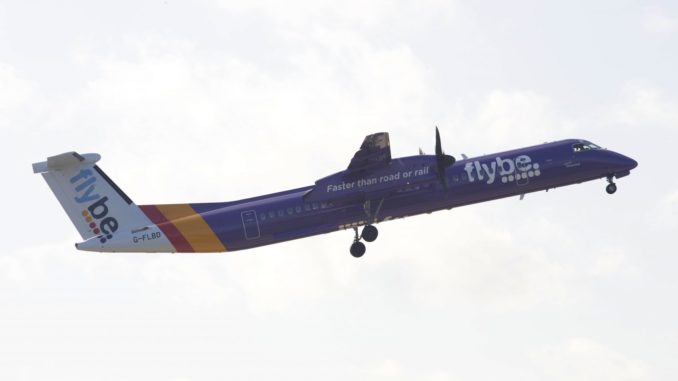
A Flybe (BE/BEE) Dash 8-Q400 (G-JECN) hit a Ground Power Unit at Southampton Airport earlier this year because the pilots had forgotten to turn on the Standby Hydraulics.
The aircraft had arrived at Southampton Airport (SOU/EGHI) from Jersey (JER/EGJJ) on the 2nd March 2019 and was operating the last of its four revenue flights that day.
After landing the pilots shut down engine No1 (port) and taxied to Stand 8 where it would park “nose-in”.
As it approached the stop lines the aircraft applied the brakes but the aircraft did not slow down or stop. The pilot increased pressure on the foot pedals but this did not have any effect, the brakes simply didn’t work.
The pilot, who had his hands on the thrust lever for No2 (starboard) engine, “instinctively” applied full reverse thrust which did slow the aircraft down but not sufficiently enough to avoid a collision with the stand signage which damaged the left side of the forward fuselage and right nose landing gear door.
The propellor of No 2 engine also struck a Ground Power Unit (GPU) damaging it.
On a Bombardier Dash 8 Q400 the No 1 hydraulic system includes a Standby Power Unit (SPU) which pressurises the system when the engine is shut down. When this is in use a Power Transfer Unit (PTU) should be switched on to deliver pressure into the No 2 hydraulic system
As the aircraft hit the stand furniture and GPU, the co-pilot realised that the standby hydraulic pressure selector was turned off along with the Power Transfer Unit (PTU), Both items should have been turned on during the approach.
Both the Standby Pressure Selector switch and PTU Control should have been turned on as part of the Approach Checklist, during which confirmation should also be made of the Hydraulic Pressure systems. Neither pilot had realised that the approach checklist had not been completed which led to the lack of hydraulic pressure during the taxi.
In their report to the AAIB, the Captain listed several factors that in their opinion contributed to the cause of the incident. These included:
- Failure to adhere to Standard Operating Procedures. The approach checks were not carried out, possibly due to distraction, and the after-landing checks were interrupted by the Over Speed Governor test.
- False confirmation. Until the Over Speed Governor check, the brakes worked as both engines were still running.
- Sequence interruption. The short taxi to stand barely gave time for the after-landing sequence and it was not completed correctly.
- Complacency. This was a return to home base after four sectors. The previous three arrivals and taxi-in phases had all been normal.
- ‘Startle factor’. Combined with having his right hand on the No 2 power lever, a ‘startle factor’ produced an instinctive response in the commander to apply reverse thrust rather than apply the emergency brake.
According to the report from the Air Accident Investigations Branch (AAIB) there were no injuries to the passengers or crew, but the aircraft suffered substantial damage to its fuselage and a panel just behind the radome.
The right nose landing gear door detached and the propeller tips struck the cover of the GPU which was also damaged.
The operator, Flybe, said it considered ‘several safety barriers failed in the lead-up and during the accident’, in particular, that the approach checks were not carried out and if they had have been, would have ‘captured the incorrect aircraft configuration’. The use of the emergency brakes instead of the reverse thrust may also have prevented the collision with the stand furniture.
The report notes that Flybe has said it has carried out a safety study which produced several additional observations to be considered regarding the approach checklist design and the single-engine taxi risk assessment.
The airline has sent out a Notice to Air Crew (NOTAC) ensuring a No 1 hydraulic system check is carried out during post-landing taxi.
